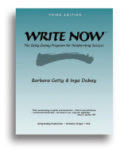“Many parents have thanked me for helping their child develop this attractive, legible handwriting.”
Vicki Swartz, National Teachers Hall of Fame
Why Italic?
Natural to write, easy to teach, fun to learn — watch the 2 minute video.
What is Italic?
These days, we may think about “italic” as a way to make writing slanted on a word processor, for emphasis or a quotation.
But italic handwriting is a style of writing developed five centuries ago in the Italian Renaissance. The first instruction manual of the italic script was La Operina by Arrighi, printed in Rome in 1522. Getty-Dubay Italic is closely based on this historical style.
Most handwriting styles have a print and a cursive form — and so does italic.


Here are some examples of available handwriting methods. You can see that, unlike with Getty-Dubay Italic, the other methods require that you change letterforms between print and cursive forms.
Comparison of common handwriting systems
Download this chart | Compare specific letters
- Italic print and cursive letterforms are identical — there is no need to learn new letterforms for cursive.
- Italic is cleaner — there are no loops or excessive serifs to mask the letter.
- Italic is more natural — the basic shapes are ovals and sloped lines, rather than circles and vertical lines that are more difficult to replicate.
Italic handwriting is:
Legible - it has an uncluttered flow, even when written rapidly
Logical - it has an easy transition from printing to cursive writing
Easy to write - its shapes and strokes are a natural fit for hand movements
Easy to learn - it is simple to get the basics across with a step-by-step approach
Click here for italic handwriting examples.
The following New York Times Op-Ed by authors Barbara Getty and Inga Dubay makes the case that all cursive styles are not equal. We need a cursive style that meets the demands of modern life, allowing us to move easily from print to script. We need Getty-Dubay Italic cursive.
Why Cursive? | Why Calligraphy?
Learn more about the Getty-Dubay® workbooks that bring legibility and ease to the everyday experience of writing
Write Now for adults | Italic Handwriting Series for K-6





